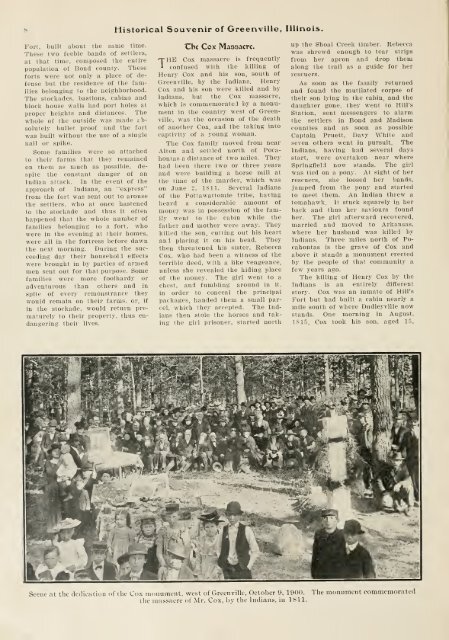Historical souvenir of Greenville, Illinois : being a ... - University Library
Historical souvenir of Greenville, Illinois : being a ... - University Library
Historical souvenir of Greenville, Illinois : being a ... - University Library
You also want an ePaper? Increase the reach of your titles
YUMPU automatically turns print PDFs into web optimized ePapers that Google loves.
Fort, built about the same time.<br />
These two feeble bands <strong>of</strong> settlers,<br />
at that time, composed the entire<br />
population <strong>of</strong> Bond county. These<br />
forts were not only a place <strong>of</strong> defense<br />
but the residence <strong>of</strong> the families<br />
belonging to the neighborhood.<br />
The stockades, bastions, cabins and<br />
block house walls had port holes at<br />
proper heights and distances. The<br />
whole <strong>of</strong> the outside was made £.bsolutely<br />
bullet pro<strong>of</strong> and the fort<br />
was built without the use <strong>of</strong> a single<br />
nail or spike.<br />
Some families were so attached<br />
to their farms that they remained<br />
on them as much as possible, despite<br />
the constant danger <strong>of</strong> an<br />
Indian attack. In the event <strong>of</strong> the<br />
approach <strong>of</strong> Indians, an "express"<br />
from the fort was sent out to arouse<br />
the settlers, who at once hastened<br />
to the stockade and thus it <strong>of</strong>ten<br />
happened that the whole number <strong>of</strong><br />
families belonging to a fort, who<br />
were in the evening at their homes,<br />
were all in the fortress before dawn<br />
the next morning. During the succeeding<br />
day their householl effects<br />
were brought in by parties <strong>of</strong> armed<br />
men sent out for that purpose. Some<br />
families were more foolhardy or<br />
adventurous than others and in<br />
spite <strong>of</strong> every remonstrance they<br />
would remain on their farms, or, if<br />
in the stockade, would return prematurely<br />
to their property, thus endangering<br />
their lives.<br />
<strong>Historical</strong> Souvenir <strong>of</strong> <strong>Greenville</strong>, <strong>Illinois</strong>.<br />
THE<br />
'Cht Cox Massacre.<br />
Cox massacre is frequently<br />
confused with the killing <strong>of</strong><br />
Henry Cox and his son, south <strong>of</strong><br />
<strong>Greenville</strong>, by the Indians. Henry<br />
Cox and his son were killed and by<br />
Indians, but the Cox massacre,<br />
which is eommemorateJ by a monument<br />
in the country west <strong>of</strong> <strong>Greenville</strong>,<br />
was the occasion <strong>of</strong> the death<br />
<strong>of</strong> another Cox, and the taking into<br />
captivity <strong>of</strong> a young woman.<br />
The Cox family moved from near<br />
Alton and settled north <strong>of</strong> Pocahontas<br />
a distance <strong>of</strong> two miles. They<br />
had been there two or three years<br />
and were building a horse mill at<br />
the time <strong>of</strong> the murder, which was<br />
on June 2, ISll. Several Indians<br />
<strong>of</strong> the Pottawattomie tribe, having<br />
heard a considerable amount <strong>of</strong><br />
money was in possession <strong>of</strong> the family<br />
went to the cabin while the<br />
father and mother were away. They<br />
killed the son, cutting out his heart<br />
an! placing it on his head. They<br />
then threatened his sister, Rebecca<br />
Cox. who had been a witness <strong>of</strong> the<br />
terrible deed, with a like vengeance,<br />
unless she revealed the hiding place<br />
<strong>of</strong> the money. The girl went to a<br />
chest, and fumbling around in it,<br />
in order to conceal the principal<br />
packages, handed them a small parcel,<br />
which they accepted. The Indians<br />
then stole the horses and taking<br />
the girl prisoner, started north<br />
up the Shoal Creek timber. Rebecca<br />
was shrewd enough to tear strips<br />
from her apron and drop them<br />
along the trail as a guide for her<br />
rescuers.<br />
As soon as the family returned<br />
and found the mutilated corpse <strong>of</strong><br />
their son lying in the cabin, and the<br />
daughter gone, they went to Hill's<br />
Station, sent messengers to alarm<br />
the settlers in Bond and Madison<br />
counties and as soon as possible<br />
Captain Pruett, Davy White and<br />
seven others went in pursuit. The<br />
Indians, having had several days<br />
start, were overtaken near where<br />
Springfield now stands. The girl<br />
was tied on a pony. At sight <strong>of</strong> her<br />
rescuers, she loosed her bands,<br />
jumped from the pony and started<br />
to meet them. An Indian threw a<br />
tomahawk. It stuck squarely in her<br />
back and thus her saviours found<br />
her. The girl afterward recovered,<br />
married and moved to Arkansas,<br />
where her husband was killed by<br />
Indians. Three miles north <strong>of</strong> Pocahontas<br />
is the grave <strong>of</strong> Cox and<br />
above it stands a monument erected<br />
by the people <strong>of</strong> that community a<br />
few years ago.<br />
The killing <strong>of</strong> Henry Cox by the<br />
Indians is an entirely different<br />
story. Cox was an inmate <strong>of</strong> Hill's<br />
Fort but had built a cabin nearly a<br />
mile south <strong>of</strong> where Dudleyville now<br />
stands. One morning in August,<br />
1S15, Cox took his son, aged 15,<br />
Scene at the dec cation <strong>of</strong> the Cox monument, west <strong>of</strong> <strong>Greenville</strong>, October 9, lyno. The moiuiinent commemorated<br />
the massacre <strong>of</strong> Mr. Cox, by the Indians, in 181 1.










![Novellen [microform] - University Library](https://img.yumpu.com/21939450/1/171x260/novellen-microform-university-library.jpg?quality=85)
![Anecdota Chisiana de re metrica [microform]](https://img.yumpu.com/21939448/1/190x239/anecdota-chisiana-de-re-metrica-microform.jpg?quality=85)



![Schollenbruch [microform] : Gedichte - University Library](https://img.yumpu.com/21939437/1/174x260/schollenbruch-microform-gedichte-university-library.jpg?quality=85)

